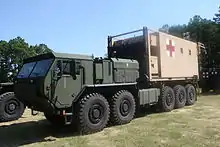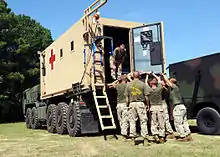Mobile Trauma Bay
A Mobile Trauma Bay is a containerized ambulance bay mounted on an Oshkosh Logistic Vehicle System Replacement (LVSR).[1][2] It holds state-of-the-art medical equipment and carries a Shock Trauma Platoon, generally consisting of one doctor, a nurse and three corpsmen, providing advanced resuscitative care to critically injured service members within the first hour after a traumatic injury (the "golden hour"). It takes emergency medical care far forward, saving more lives.[3][4] Over 98% of the wounded Marines who make it into the MTB, make it out alive.[5]

A Mobile Trauma Bay mounted on an Oshkosh Logistic Vehicle System Replacement (LVSR)

A Mobile Trauma Bay mounted on an Oshkosh Logistic Vehicle System Replacement (LVSR)
History
The MTB was designed and developed by James L. Hancock in 2008.[6][7] There were 914 concept drawings over the four-month period from design to deployment.[8]
References
- Chris Lawrence, CNN Pentagon Correspondence, “An Armored Emergency Room Doesn't Have to Wait for the Wounded.” CNN, April 12, 2010, accessed September 12, 2013.
- Col. Oliver North, "Report From a Forgotten War: Second in a Series." FoxNews.com, August 14, 2008, accessed September 12, 2013.
- Lance Cpl. Khoa Pelczar, "Mobile Trauma Bay Brings Medical Care Closer to Battlefield Archived 2013-11-02 at the Wayback Machine," 1st Marine Logistics Group, May 1, 2010, accessed September 15, 2013.
- “ShockTrauma Platoon Extends Golden Hour For Marines,” America’s North Shore Journal, October 14, 2008, accessed August 24, 2013.
- Ben Roberts, “Special Report: Rolling Warfront E-R,” WALB News 10, May 2, 2011, accessed August 28, 2013.
- "Captain James L. Hancock, Deputy Commander, Naval Medical Center Portsmouth Archived 2009-03-09 at the Wayback Machine," Navy Medicine. United States Navy. Accessed August 24, 2013.
- Amanda Hickey, "Lejeune Officer's Portable ER Saving Lives in the Field," newsobserver.com, August 23, 2009, accessed September 22, 2013.
- Marine Corps Base Camp Lejeune, August 27, 2009, accessed September 22, 2013.
External links
This article is issued from Wikipedia. The text is licensed under Creative Commons - Attribution - Sharealike. Additional terms may apply for the media files.